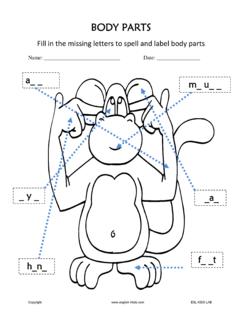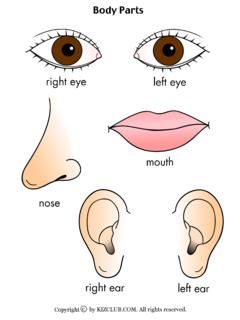Transcription of EarlyChildDevelopmentKit: ATreasureBoxofActivities
1 Early Child Development Kit:A Treasure Box of ActivitiesActivity GuideUNICEFECD UnitJuly 2009 Working DraftAcknowledgmentsThisprototypedocumen t* sFund(UNICEF),itsaffiliatedorgani-zation s, ,orofitsauthorities, *This prototype will be finalized and published after extensive consultation with the fieldimplementers and feedback received from our different more information, please contact:Early Childhood Development / PDOUNICEF House3 UN PlazaNew York, NY 10017 USAE-mail: +1 212 824 6554iEarly Child Development Kit:A Treasure Box of ActivitiesActivity GuideWelcome!
2 How much are young children affected by events that take place around them?A lot. Young children are active players in the world. Even though they may not understandthe meaning of what they see or hear, children absorb the images that surround them andare deeply impacted by the emotions of the people they rely on for love and and caregivers play a very important role in helping young children cope withand recover from traumatic and stressful experi-ences. Providing young children with sensitive andresponsive care takes a lot of emotional and physi-cal energy.
3 But the everyday moments sharedbetween a child and caring adults can be mutuallyhealing. During difficult and uncertain times, sim-ply finding comfort in each other s presence is thefirst step to helping young children cope and Power of PlayChildren are curious from the moment they are born. They want to learn about andunderstand their world. During the first five years of life children s brains are growingfaster than at any other time of life. Children s early experiences shape how their brainsdevelop. Children s early learning sets the stage for school early experiences help a child s brain develop well.
4 The more work the brain does,the more it is capable of doing. When children play, their brains work is how children learn. Play comes naturally to children. They play during dailyroutines. They play during learning experiences you provide. Think about a baby whostarts a peek-a-boo game with you when you pull her shirt over her head. The toddler ortwo-year-old who imitates the way you read to her as she reads to her doll. Or the three-or-four year old who scribbles and marks on a large sheet of paper you put out on thetable, then announces proudly, I wrote my name.
5 Sometimes it may look like not much is happening. Filling and dumping small objectsfrom a can may seem boring to you. Playing blocks seems like just stacking them andknocking them play is filled with opportunities for children to learn and develop new skills. Whenchildren play, they use all their senses hearing, seeing, tasting, touching, smelling andmoving to gather information about their world. Later they will gather informationthrough language. They organize and reorganize this information into their first picturesof themselves, others, and their the fun games in this Treasure Box, children both older and younger willdevelop new skills for talking and thinking, moving and doing, feeling and learningabout themselves, and getting along with through PlayLook at how much children are learning as they play together with blocks:Talking and ThinkingThey may learn to.
6 Connect words to actionsas they talk together about what they are in conversationsabout what they are position wordsas they walkona path of blocksnext tothe conceptssuch as soft, hard, big, small, heavy, light, rough and their imaginationas they tell a story about what they a planas they decide what to build a taskas they make a path of and DoingThey may learn to:Develop awareness of where they are goingas theywalk on a path of balance when movingas they carryblocks across the hand and wrist muscles to do delicatetasksas they make a stack of and learning about self:They may learn to:Express their feelingswhen they discover: I like to build.
7 Feel I can do it! as they complete a tower of blocks or knock a block tower Along with othersThey may learn to:Play with other with othersas one child hands another a a simple rulethat keeps everyone safe, such as no throwing blocks. iiiWhy an ECD Kit?Giving time for and helping children play during times of stress is one of the mostimportant things you can do. This ECD Kit of activities was created to help you helpyoung children continue to develop their skills for thinking, speaking, and interactingwith people and things even when times are very difficult.
8 We hope these fun learningactivities will help to stimulate children s eager minds, quiet their hearts, and give themhope. When you help young children feel safe and secure they can be free to learn nowand in the is inside the ECD Kit?This ECD Treasure Box is filled with materials and ideas for learning and fun. Each itemwas carefully chosen to support the important work you do each day. Each one can beused in different ways depending on the age and interest of the child. Here is a list ofthe children s treasures you will and ActivitiesBabies1 3 Years4 6 Years1.
9 Board Puzzle**2. Chain Puzzle**3. Board Book**4. Sponge Balls**5. Shape Sorter**6. Paper and Crayons** Beads** **9. Stack and Sort Kit**10. Dominoes**11. ConstructionBlocks**12. Modeling Clay**13. Puzzle Blocks**14. Memory Game**15. Counting Circle*16. Jigsaw Puzzle*ivTreasures for CaregiversThe ECD kit also contains materials to help you create a safe learning space for youngchildren. Look for tape, pen, pencils, paper, exercise book markers, and flipcharts. Awater container and soap will help you to keep the materials and children CardsThese activity cards have been developed to help you use the materials in the ECD is one activity sheet for each item.
10 The activities are arranged from easier to hard-er. Each item can be used in different ways for babies, for children from one to threeyears; and children from four to six symbols will help you find the right activity for the right 3 years4 6 yearsEach activity sheet also includes:What you can doIdeas for how to use the material to help children sdevelop skills for talking and thinking, moving anddoing, learning about self and getting along with to look forThings to observe in children as they playPossible extensionsSuggestions for other things you might doCautionTips to help you keep children safe while playingChildren are learning from you and each other all the time.











